Automotive Predictive Technology Market Size
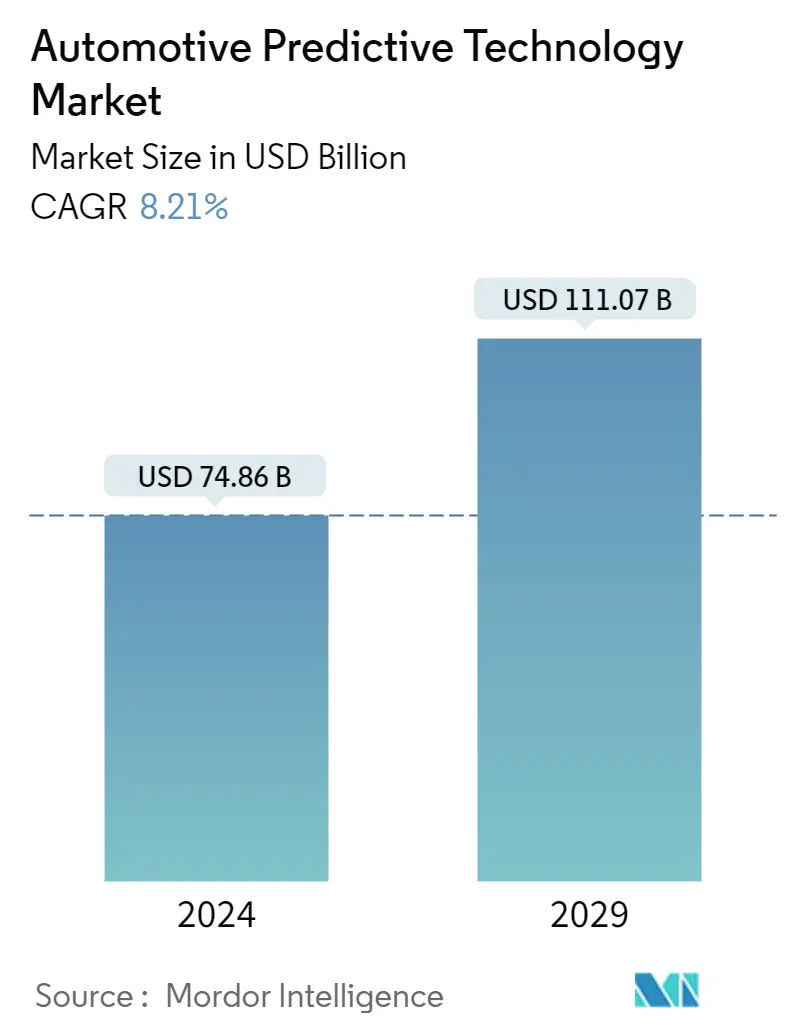
| Study Period | 2019 - 2029 |
| Market Size (2024) | USD 74.86 Billion |
| Market Size (2029) | USD 111.07 Billion |
| CAGR (2024 - 2029) | 8.21 % |
| Fastest Growing Market | Asia-Pacific |
| Largest Market | Asia-Pacific |
Major Players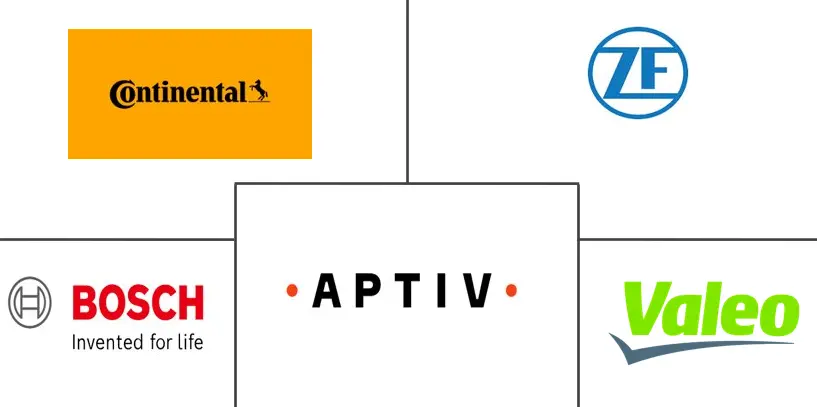
*Disclaimer: Major Players sorted in no particular order |
Automotive Predictive Technology Market Analysis
The Automotive Predictive Technology Market size is estimated at USD 74.86 billion in 2024, and is expected to reach USD 111.07 billion by 2029, growing at a CAGR of 8.21% during the forecast period (2024-2029).
- The outbreak of COVID-19 negatively impacted the automotive predictive technology market. Several vehicles and component manufacturing facilities worldwide were temporarily shut down, resulting in disturbances in the supply chain. However, the automotive industry started recovering slightly and is expected to continue during the forecast period.
- The growing trend of technologically advanced features in the vehicles, such as artificial intelligence and machine learning to enhance safety features like advanced driver-assistance systems (ADAS) and predictive maintenance focused on reducing vehicle downtime and increasing vehicle performance cost-effectively, is driving the market growth.
- Autonomous vehicles and self-driving technologies also use several predictive features to alert drivers about obstacles and produce other driving alerts. Several major original equipment manufacturers (OEMs) are investing heavily in developing autonomous vehicles, and such developments are expected to offer new opportunities for players in the market.
- Asia-Pacific is expected to dominate the automotive predictive technology market, owing to the increasing demand for luxury vehicles across India, China, and Japan. The increasing installation of advanced driver-assistance systems (ADAS) is also estimated to boost the demand for such technologies in the coming years across the region.
Automotive Predictive Technology Market Trends
ADAS Segment Likley to Dominate the Market During the Forecast Period
- In recent years, the automobile industry has motivated its research and development work to improve ADAS systems. This led to further improvements in the advanced driving assistance systems, with a surge in demand for night-time pedestrian detection systems, lane departure warning systems, cameras, RADAR, and other sensors, which are being deployed into vehicles at a considerable pace. So, players continuously focus on deploying products with such technologies to drive demand in the market.
- In July 2022, Hyundai Motor India made a significant stride in automotive technology with the launch of an upgraded version of its top-tier sports utility vehicle (SUV), the Tucson. Boasting level 2 advanced driving assistance systems (ADAS) capability, this SUV introduces a new era of intelligent driving features. Among the groundbreaking features is an automated sensing technology that combines the power of cutting-edge cameras and radar sensors. With this innovative setup, Tucson can now accurately detect other vehicles, pedestrians, and even cyclists on the road.
- Moreover, companies like Audi, BMW, Daimler, and Volvo are a few of many original equipment manufacturers (OEMs) that started offering night-time pedestrian detection systems. It alerts the driver or automatically brakes if there is a pedestrian in the path between a certain speed range.
- For instance, in November 2022, Zenseact, a software company, introduced artificial intelligence (AI)-powered software, Onepilot, that will offer drivers a new level of safety in Volvo's fully electric flagship SUV, the Volvo EX90.
- Several major service providers are spending heavily on research and development of the latest ADAS technologies for vehicles to gain market share. Not only the major companies but several startups are also coming up with the latest innovative ideas and technologies, which are funded by these major players.
- Due to such developments, the ADAS segment is expected to dominate the market during the forecast period.
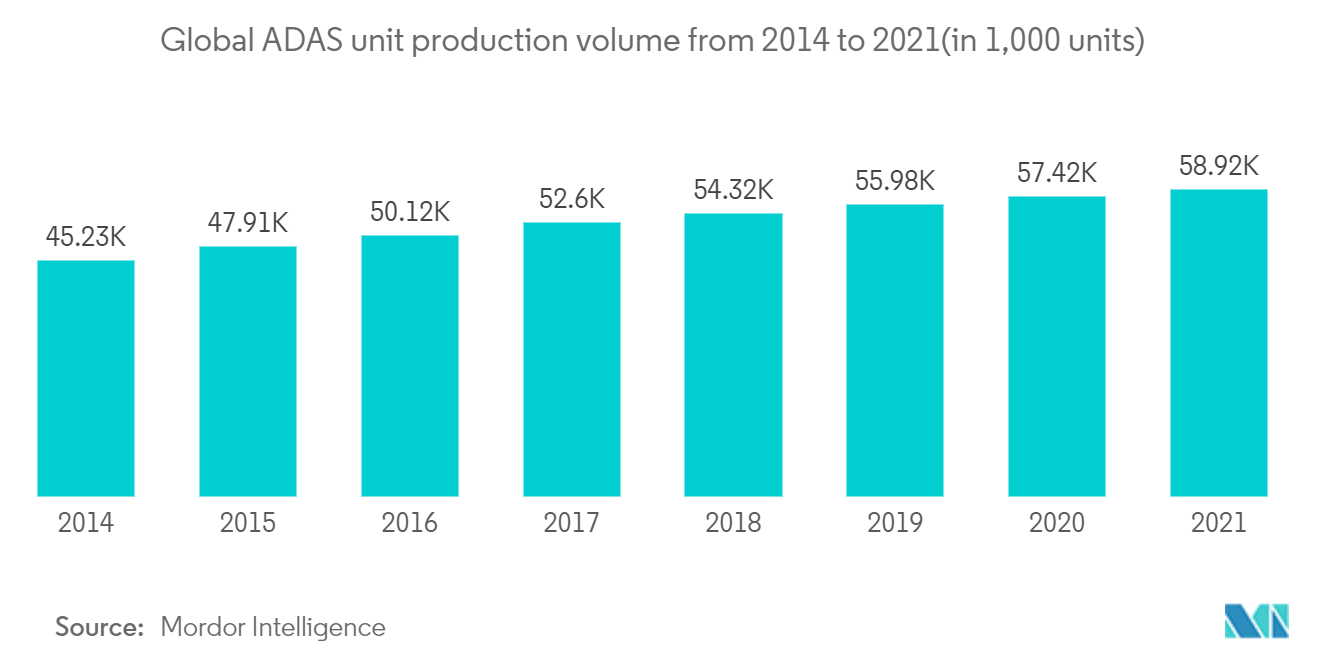
Asia-Pacific Expected to Hold Significant Market Share
- Asia-Pacific is expected to be the fastest-growing market during the forecast period. Vehicle hybridization and electrification and increasing production of electric vehicles are the primary factors driving the demand. Countries like India, China, and Japan are picking up the pace as predictive technology implementation in passenger cars is taking place gradually, as such cars or commercial vehicles equipped with such technology are in a bit higher price segment. Poor infrastructure and regulations are other reasons responsible for slow adoption.
- Automobile manufacturers in the Asia-pacific region are also investing in predictive technology and launching new products equipped with features based on predictive technology.
- For instance, in May 2023, the Bengaluru-based Continental Technology Centre India is making significant strides in the development of advanced driver assistance systems (ADAS) tailored specifically to Indian road conditions. Their efforts have resulted in modular ADAS solutions, which can be readily adapted to various vehicle platforms, ensuring seamless integration and compatibility.
- In July 2021, a pioneering Indian start-up named Minus Zero achieved a remarkable milestone by successfully creating an autonomous system powered by cutting-edge AI and machine learning technologies. This innovative system is purposefully designed to function optimally amidst the unique challenges posed by Indian traffic conditions.
- Such factors are creating huge opportunities for predictive technology across Asia-Pacific. The demand for such technologies is expected to increase in the near future.
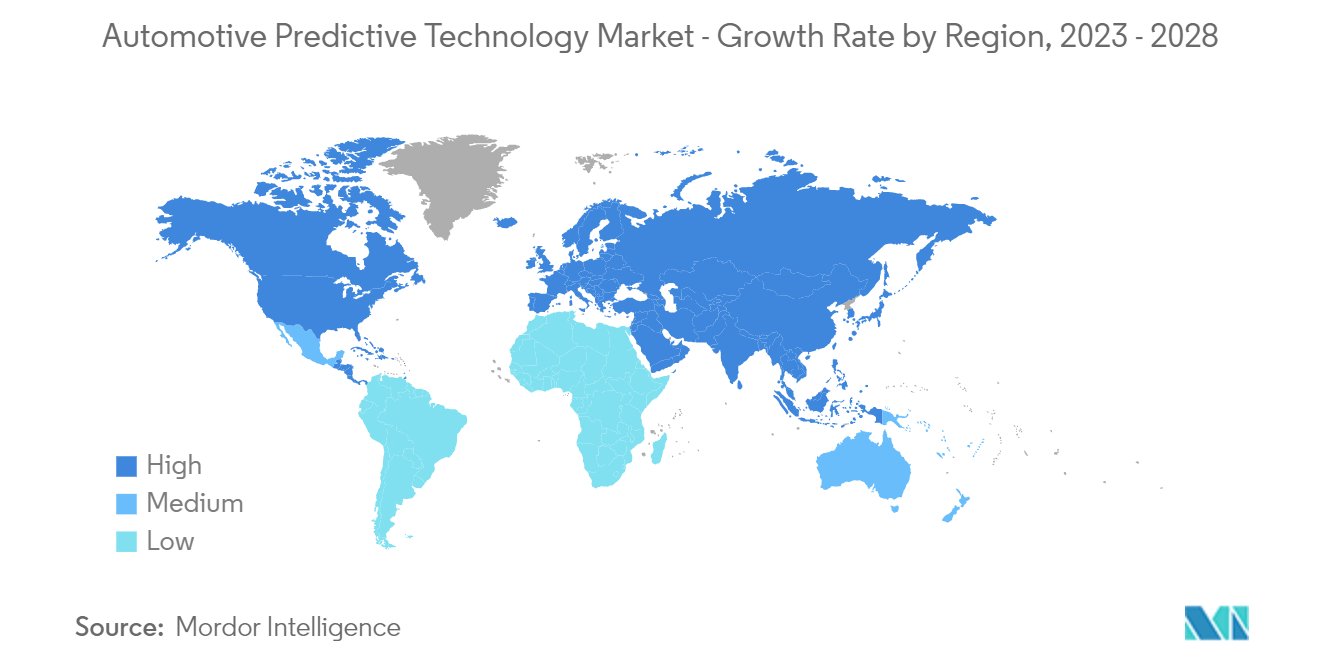
Automotive Predictive Technology Industry Overview
The automotive predictive technology market is moderately consolidated as it accommodates several major and new players vying for significant market share. Some of the prominent companies in the automotive predictive technology market include Continental AG, ZF Friedrichshafen AG, Robert Bosch, Aptiv PLC, and Valeo SA. These companies are focusing on strategic collaborative initiatives to expand their market shares and profits.
For instance, in April 2022, ZF launched a pioneering collision mitigation system (CMS) designed for city buses. This innovative system provides active braking to prevent frontal collisions with other road users, such as vehicles, bicycles, and pedestrians. Additionally, the CMS effectively mitigates the negative effects of braking momentum on passengers, ensuring their safety and comfort.
Automotive Predictive Technology Market Leaders
-
Continental AG
-
Aptiv
-
ZF Friedrichshafen AG
-
Robert Bosch
-
Valeo SA
*Disclaimer: Major Players sorted in no particular order
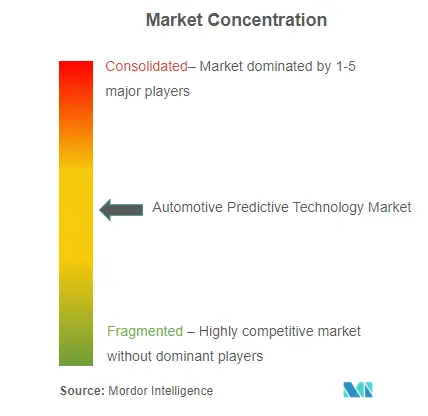
Automotive Predictive Technology Market News
- January 2023: ZF, the world's leading supplier of automotive cameras, developed Smart Camera 6, its next generation of cameras for the advanced development of urban and highway automated driving and safety systems. ZF also offers multi-sensor environmental monitoring through image processing module systems to offer 3D surround view, interior monitoring systems, and more.
- January 2023: Continental and Ambarella, Inc. announced a strategic partnership to jointly develop scalable, end-to-end hardware and software solutions based on artificial intelligence (AI) for assisted and automated driving (AD).
Automotive Predictive Technology Market Report - Table of Contents
1. INTRODUCTION
- 1.1 Study Assumptions
- 1.2 Scope of the Study
2. RESEARCH METHODOLOGY
3. EXECUTIVE SUMMARY
4. MARKET DYNAMICS
-
4.1 Market Drivers
- 4.1.1 Increasing Demand For Connected Cars
- 4.1.2 Advancements In Data Analytics And Machine Learning
-
4.2 Market Restraints
- 4.2.1 High Implementation And Maintenance Costs
-
4.3 Porter's Five Forces Analysis
- 4.3.1 Threat of New Entrants
- 4.3.2 Bargaining Power of Buyers/Consumers
- 4.3.3 Bargaining Power of Suppliers
- 4.3.4 Threat of Substitute Products
- 4.3.5 Intensity of Competitive Rivalry
5. MARKET SEGMENTATION
-
5.1 Vehicle Type
- 5.1.1 Passenger Vehicles
- 5.1.2 Commercial Vehicles
-
5.2 End-User
- 5.2.1 Fleet Owners
- 5.2.2 Insurers
- 5.2.3 Other End-Users
-
5.3 Hardware Type
- 5.3.1 ADAS
- 5.3.2 On-board Diagnosis
- 5.3.3 Other Hardware Types
-
5.4 Geography
- 5.4.1 North America
- 5.4.1.1 United States
- 5.4.1.2 Canada
- 5.4.1.3 Rest of North America
- 5.4.2 Europe
- 5.4.2.1 Germany
- 5.4.2.2 United Kingdom
- 5.4.2.3 France
- 5.4.2.4 Rest of Europe
- 5.4.3 Asia-Pacific
- 5.4.3.1 China
- 5.4.3.2 India
- 5.4.3.3 Japan
- 5.4.3.4 South Korea
- 5.4.3.5 Rest of Asia-Pacific
- 5.4.4 Rest of the World
- 5.4.4.1 Brazil
- 5.4.4.2 Mexico
- 5.4.4.3 United Arab Emirates
- 5.4.4.4 Other Countries
6. COMPETITIVE LANDSCAPE
- 6.1 Vendor Market Share**
-
6.2 Company Profiles*
- 6.2.1 Continental AG
- 6.2.2 Aptiv PLC
- 6.2.3 Garrett Motion Inc.
- 6.2.4 Harman International Industries Incorporated
- 6.2.5 Visteon Corporation
- 6.2.6 ZF Friedrichshafen AG
- 6.2.7 Valeo SA
- 6.2.8 Robert Bosch GmbH
- 6.2.9 Verizon
- 6.2.10 Infineon Technologies AG
7. MARKET OPPORTUNITIES AND FUTURE TRENDS
- 7.1 Integration With Advanced Driver Assistance Systems (ADAS)
Automotive Predictive Technology Industry Segmentation
Automotive predictive vehicle technology is a set of vehicle technologies that incorporate predictive analytics with the use of real-time and historical data that forecast activity, behavior, and faults that may hamper vehicles if not corrected in real time. The report covers the latest trends, COVID-19 impact, and technological developments in the market.
The scope of the report covers segmentation based on vehicle type, end user, hardware type, and geography. By vehicle type, the market is segmented into passenger cars and commercial vehicles. By end-user, the market is segmented into fleet owners, insurers, and other end-users. By hardware type, the market is segmented into ADAS, onboard diagnostics, and other hardware types. By geography, the market is segmented into North America, Europe, Asia-Pacific, and the Rest of the World.
For each segment, market sizing and forecast have been done on the basis of Value (USD).
| Vehicle Type | Passenger Vehicles | |
| Commercial Vehicles | ||
| End-User | Fleet Owners | |
| Insurers | ||
| Other End-Users | ||
| Hardware Type | ADAS | |
| On-board Diagnosis | ||
| Other Hardware Types | ||
| Geography | North America | United States |
| Canada | ||
| Rest of North America | ||
| Geography | Europe | Germany |
| United Kingdom | ||
| France | ||
| Rest of Europe | ||
| Geography | Asia-Pacific | China |
| India | ||
| Japan | ||
| South Korea | ||
| Rest of Asia-Pacific | ||
| Geography | Rest of the World | Brazil |
| Mexico | ||
| United Arab Emirates | ||
| Other Countries |
Automotive Predictive Technology Market Research FAQs
How big is the Automotive Predictive Technology Market?
The Automotive Predictive Technology Market size is expected to reach USD 74.86 billion in 2024 and grow at a CAGR of 8.21% to reach USD 111.07 billion by 2029.
What is the current Automotive Predictive Technology Market size?
In 2024, the Automotive Predictive Technology Market size is expected to reach USD 74.86 billion.
Who are the key players in Automotive Predictive Technology Market?
Continental AG, Aptiv , ZF Friedrichshafen AG, Robert Bosch and Valeo SA are the major companies operating in the Automotive Predictive Technology Market.
Which is the fastest growing region in Automotive Predictive Technology Market?
Asia-Pacific is estimated to grow at the highest CAGR over the forecast period (2024-2029).
Which region has the biggest share in Automotive Predictive Technology Market?
In 2024, the Asia-Pacific accounts for the largest market share in Automotive Predictive Technology Market.
What years does this Automotive Predictive Technology Market cover, and what was the market size in 2023?
In 2023, the Automotive Predictive Technology Market size was estimated at USD 69.18 billion. The report covers the Automotive Predictive Technology Market historical market size for years: 2019, 2020, 2021, 2022 and 2023. The report also forecasts the Automotive Predictive Technology Market size for years: 2024, 2025, 2026, 2027, 2028 and 2029.
Predictive Vehicle Technology Industry Report
The Global Automotive Predictive Analytics Market Trends report provides an in-depth industry analysis, covering various segments such as vehicle type, end user, hardware type, and geography. The report highlights the market size and market share for automotive predictive technology, offering valuable insights into market growth and market trends.
The market forecast includes a detailed industry overview and market outlook, focusing on key market leaders and market segmentation. The report also provides industry statistics and industry research, ensuring a comprehensive understanding of the market value and industry size.
Fleet owners, insurers, and other end users are analyzed, with particular attention to the hardware types such as ADAS and on-board diagnostics. The market review includes industry reports and industry information, presenting a thorough examination of market data and market predictions.
The report example and report PDF offer a clear view of the market research, supported by industry reports and industry research. The industry outlook and market predictions are backed by extensive industry sales and industry trends, ensuring an accurate market forecast and market growth rate.
Overall, the report is a valuable resource for understanding the market segmentation and market value, providing a detailed industry overview and market analysis. The industry statistics and market data presented in the report are crucial for making informed decisions in the automotive predictive technology sector.



